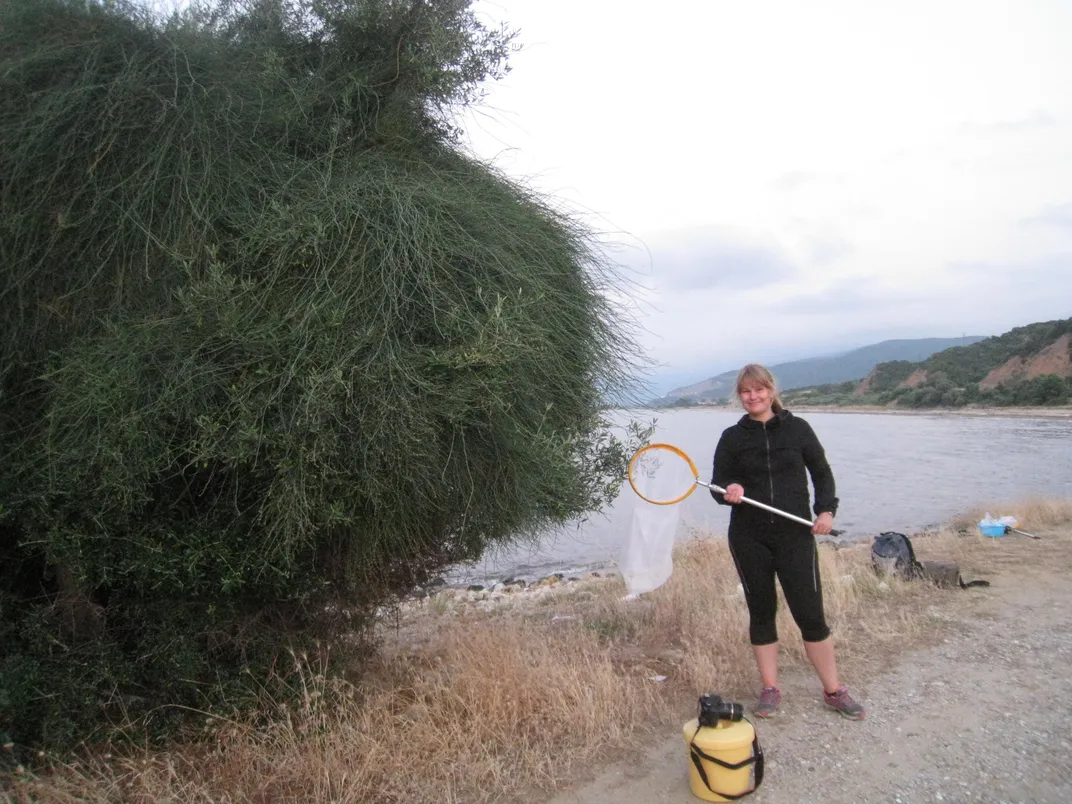“Wereplant” Releases Its Pollen By the Light of the Full Moon
An unassuming shrub from the Mediterranean is the first documented case of a plant timing its reproduction to the lunar cycle
/https://tf-cmsv2-smithsonianmag-media.s3.amazonaws.com/filer/cf/b8/cfb8503d-dee6-46ed-8553-f8305777a071/plant_i.jpg)
Many animals depend on the lunar cycle for a multitude of purposes, from communication to navigation. Now researchers have found the first known plant that only reproduces by the light of the full moon. The plant may represent the lone surviving example of an ancient, once-bountiful pollination system, the researchers report this week in Biology Letters.
Looking at Ephedra foeminiea by the light of day, the plant seems like no more than an unassuming tangle of dull green branches. “Ephedra foeminea is a big, scrambling shrub, rather ugly in fact,” Catarina Rydin, a botanist at the University of Stockholm and one of the researchers behind the discovery, says in an email. The shrub hangs from cliffs or clings to olive trees in the eastern Mediterranean region, and its leaves are so tiny that some call it the leafless Ephedra. But when the shrub is ready to reproduce, E. foeminiea acts as a sort of wereplant, transforming itself into a fertile mass of bright red and yellow cones.
Rydin and her doctoral student, Kristina Bolinder, were investigating the shrub because of its long evolutionary history. Ephedra’s relatives, which first arose about 130 million years ago in the Early Cretaceous, likely served as dinosaur food. Like others of its kind, Ephedra plants don't have flowers and instead secrete droplets of pollen-laden liquid from their cones. Some species let the wind ferry drops between cones, but the liquid is also high in sugar, which attracts insects.
Rydin suspects that Ephedra might have saved itself from extinction by shifting from a predominantly insect-pollinated system to one dependent on wind, based on observations she has made in the fossil record. "Historically, climate change has occurred repeatedly, not least in the aftermath of the meteorite impact 65 million years ago, and wind-pollination may have been a safer method to ensure reproduction during such times," she says. "It is thus possible that insect-pollinated species of Ephedra had a greater risk of becoming extinct."
To better understand the plants and their evolution, the two researchers headed down to Greece, where they scrambled over rocks to count insects and keep an eye out for pollen droplets. They had already determined that E. distachya, one of E. foeminea’s close relatives, sent its pollen riding on the wind—a finding that matches most other Ephedra species researchers have taken the time to study. But E. foeminiea’s pollination methods remained more elusive. Even after its cones appeared, they refused to open, and the usual suspects among insect pollinators seemed uninterested.

One night over a Greek dinner, the two began musing about something they’d recently read about nocturnal insects using the moon to navigate. Suddenly—presumably with the help of wine—an idea struck: Could E. foeminiea’s pollination somehow be connected to the lunar cycle? “It started as a joke that evening, I should say,” Rydin says.
Still, the joke seemed plausible enough that she and Bolinder decided to investigate. They eagerly bided their time in the field, reading up about nocturnal pollination and counting down the nights until the July full moon. On that long-awaited evening, the researchers strategically positioned themselves in an open field of E. foeminiea and waited. As the moon rose in the cloudless sky, its soft glow revealed droplets of pollen, which shimmered and sparkled on the brightly colored cones. “We may be biased,” Rydin says, “but we found it ever so beautiful.”
Whereas most nocturnally blooming plants have white flowers to help pollinators find them in the dark, E. foeminiea’s cones are red and yellow, and they emit no discernable scent. “It became clear to us that the glittering probably is the means of nocturnal attraction that we had searched for but not found before,” Rydin says. That display likely acts as a homing beacon for insects, including the flies and moths that the researchers observed alighting on E. foeminiea that evening.
Although the light of the half moon would likely be sufficient to illuminate the pollen, the full moon alone remains up throughout the entire night, so the researchers think that E. foeminiea maximizes the effect for efficiency. “Only at full moon do the insects have a moon to navigate by during the entire night,” Rydin says.
So far, the researchers only have that one spectacular display, backed up by a scattering of historical data that seems to support the pattern. While some pollen drops did appear during the full moons of August and September, there were significantly fewer cones, suggesting that E. foeminiea, like its relatives, peaks in summer. As such, many mysteries remain. For instance, how do the plants “know” that the full summer moon is out? The researchers point out that plants are sensitive enough to light for the moon to matter, and they can sense gravity, so they may be reacting to the changes in the moon's tidal pull. But really, Rydin admits, “we have no idea, it’s a question for the future.”
The researchers are also curious—and concerned—about another observation. Unlike the wind-pollinated E. distachya, the E. foeminiea plants mostly grow some distance from Greek towns and villages. With its dependence on getting nocturnal lighting just right, Rydin and Bolinder wonder if E. foeminiea might be suffering ill effects due to light pollution. And climate change might be an even bigger threat. If changing weather patterns begin to clog the normally clear summer sky with layers of clouds, Rydin says, that turn of events “would probably be disastrous for E. foeminiea.”
/https://tf-cmsv2-smithsonianmag-media.s3.amazonaws.com/accounts/headshot/Rachel-Nuwer-240.jpg)
/https://tf-cmsv2-smithsonianmag-media.s3.amazonaws.com/accounts/headshot/Rachel-Nuwer-240.jpg)